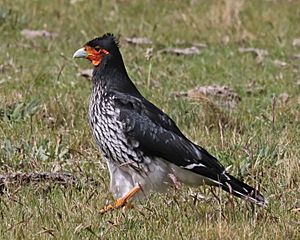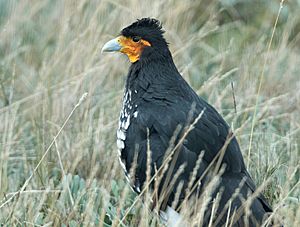Carunculated caracara facts for kids
Quick facts for kids Carunculated caracara |
|
|---|---|
 |
|
| Conservation status | |
| Scientific classification | |
| Genus: |
Phalcoboenus
|
| Species: |
carunculatus
|
 |
|
| Synonyms | |
|
|
The carunculated caracara (say: car-UN-cue-lay-ted car-a-CAR-a) is a cool bird of prey. It's part of the Falconidae family, which includes falcons and other caracaras. You can find this special bird living in the mountains of Colombia and Ecuador.
Contents
About the Carunculated Caracara
How Scientists Classify This Bird
Scientists like to group living things to understand them better. They don't always agree on the best way to group caracaras. Some groups, like the American Ornithological Society, put the carunculated caracara with three other types in a group called Phalcoboenus. Another group, BirdLife International, also places it in Phalcoboenus but with four other caracaras.
However, the Clements taxonomy places this bird with six other caracaras in a group called Daptrius. Even with these differences, everyone agrees that the carunculated caracara is a unique species. This means it doesn't have any subspecies or different types within its own species.
What Does This Bird Look Like?
The carunculated caracara is about 50 to 56 centimeters (20 to 22 inches) long. Its wings can spread out to 112 to 119 centimeters (44 to 47 inches) wide. Both male and female birds look very similar.
Most of their body is shiny black. They have cool white stripes on their chest. Their lower belly, the feathers under their tail, and the tips of their wing and tail feathers are pure white.
The skin around their beak and on their face and throat is bright orange to deep red. This skin has wrinkles, which are called "caruncles." These wrinkles give the bird its name! Their eyes are hazel or dark gray, and their legs and feet are bright yellow.
Young caracaras look a bit different. They are usually brownish with some white spots on their head, back, and underside. Their legs and feet are a bit darker.
Where Does This Bird Live?
You can find the carunculated caracara in the Andes Mountains. This mountain range stretches from southwestern Colombia all the way to southern Ecuador.
These birds live in cool mountain areas above the tree line. Their home is often a type of grassland called páramo, or grassy fields with scattered bushes. They usually live at heights between 3,000 and 4,000 meters (about 9,800 to 13,000 feet) above sea level. Sometimes, they can even be found as high as 4,700 meters (about 15,400 feet)!
How the Carunculated Caracara Behaves
Moving Around
The carunculated caracara usually stays in the same area all year. However, they do move around a bit within their home range. When it's not breeding season, you might see them gathering in large groups. Sometimes, more than 100 birds can be together!
What Does This Bird Eat?
The carunculated caracara is an omnivorous bird. This means it eats both plants and animals. It's also very good at finding food wherever it can. Its diet includes many things like worms, insects, and their larvae (young forms). They also eat other small creatures without backbones.
Sometimes, they catch small amphibians, lizards, and mammals. They might also eat baby birds from nests. If they find dead animals, they will eat those too. They even eat plant matter like grains.
These birds usually look for food by walking or running on the ground. They can also hunt while flying low. You might often see them feeding in small groups near cattle or llamas.
How Does This Bird Breed?
Carunculated caracaras usually lay their eggs in September and October. However, there are some records of them laying eggs later in the year.
They often build their nests out of sticks on a cliff ledge. But one nest was even found in a tree! A female caracara usually lays two eggs at a time. Scientists don't know much yet about how long the eggs take to hatch or how long it takes for the young birds to fly. We also don't know many details about how the parents care for their chicks.
What Sounds Does This Bird Make?
As of early 2023, there aren't many recordings of the carunculated caracara's calls. The Cornell Lab of Ornithology's Macaulay Library has only one recording of their flight calls. Another website, Xeno-canto, has that recording plus two others. One recording sounds like "grating and squealing barks." The other is described as a "long series of harsh notes."
Status of the Carunculated Caracara
The IUCN (International Union for Conservation of Nature) has looked at the carunculated caracara's situation. They have listed it as a species of "Least Concern." This is good news! It means the bird is not currently in danger of disappearing.
Even though it lives in a specific area and has an estimated population of fewer than 6,700 adult birds, its population seems to be stable. No big threats have been found that would put these birds in immediate danger. People consider them to be uncommon in some places but common in others. They are "relatively secure" because their mountain home is not facing a lot of pressure from human activities right now.
See also
 In Spanish: Curiquingue para niños
In Spanish: Curiquingue para niños




